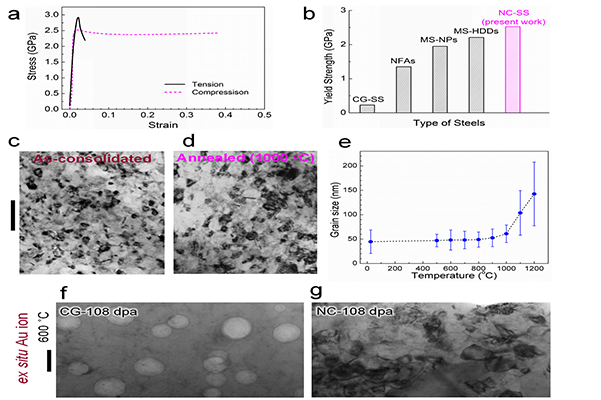[News from the News Center] Recently, YSU Prof. Shen Tongde and his team from the Clean Nano Energy Center of the State Key Laboratory of Meta-stable Materials Science and Technology cooperated with scientists at home and abroad to target the production of bulk 304L nanocrystalline austenitic steel. The austenitic steel has relative low strength and easy swelling after irradiation, meanwhile, the nanocrystalline metal is easy growing in high temperature among other issues,however, theycontribute to the production of bulk 304L ultrastrong nanocrystalline steel with exceptional thermal stability and radiation tolerance innovatively through the interface element segregation and nano-precipitation pinning. The related research results reported in the paper “Ultrastrong nanocrystalline steel with exceptional thermal stability and radiation tolerance” is published online on December 19, 2018 in Nature Communications, DOI. :10.1038/s41467-018-07712-x)
Compared with ordinary coarse-grained metals, nanocrystalline metals are stronger and more resistant to radiation. However, the thermal stability of nanocrystalline metals is generally poor, which limits their high temperature processing and application. Prof. Shen Tongde’s research group and its domestic and foreign cooperation team have developed the bulk nanocrystalline/nanoprecipitated 304L austenitic steel by using the doping of rare earth lanthanum and the high temperature and pressure synthesis technology. The nanocrystal size is about 40 nm, and the nanometer precipitation size is about 5 nm, the nano-density is as high as 5 ́1023 m-3. The nanocrystalline austenitic steel’s yield strength is up to 2500 MPa, which far exceeds the yield strength of coarse-grained 304L austenitic steel hundreds of MPa.
The nano-steel has extremely high heat and radiation stability: 800 degrees/180 hours of heat preservation, no significant grain growth; 600°/108 dpa strong irradiation causes no significant grain growth, and no radiation swelling. The experimental observations show that the ultra-high thermal stability of the nano-steel can be attributed to the thermodynamics of the segregation of lanthanum on the grain interface and the stabilization of the nano-grain by a large number of small nano-precipitation pinning kinetics. The cluster dynamics simulation shows that the ultra-high anti-irradiation swelling resistance of the nano-steel originates from a large number of grain boundaries in nano-steel, which can be used as a defect trap to greatly reduce the steady-state vacancy concentration, thereby suppressing the agglomeration and swelling of the vacancies.

a,b: Compressive and tensile mechanical behavior of nano-steel
b: The comparison of yield strength between nano steel (NC-SS) and other steels
c,d,e: Grain size of nano steel before and after annealing
f,g: Microstructure comparison of coarse grain steel and nano steel after irradiation
The research work was carried out by the team of Prof.Shen Tongde of Yanshan University, the team of Prof.Wang Yugang of Peking University, the team of Prof.Sha Gang of Nanjing University of Science and Technology, the team of Prof.Zhang Xinghang of Purdue University and the researcher of Hu Shenyang of the Pacific Northwest National Laboratory. Yanshan University is the first author of the thesis. Du Congcong, a doctoral student at Yanshan University, and Ji Shenbao, Fang Yuan and Li Jin, are the co-first authors. The corresponding authors are Shen Tongde, Wang Yugang and Sha Gang. The research work was funded by the National Natural Science Foundation of China, the National Magnetic Confinement Fusion Energy Research Project, and the Yanshan University High-level Talent Project.
[Translated by Liu Ruo ]